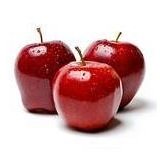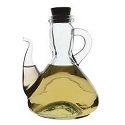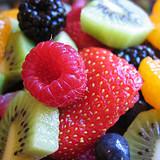Apple Nutrition Facts
Apple Nutrition Facts, Nutrition Facts About Apples, Apple Nutrients, Nutritional Benefits of Apples
Apples are very crisp with a green, yellow or red skin and white flesh. The taste does vary from juicy sweet and refreshing, to a still pleasant and refreshing sour tart. Apples are low in calories, and provide a good source of fiber and vitamin C, though compared to many other fruits and vegetables, fiber and Vitamin C are relatively low, but apples are a rich source of other antioxidant compounds such as quercetin, epicatechin, and procyanidin B-2.
There are plenty of super healing reasons why we have the saying ‘an apple a day keeps the doctor away’. Just look at the apple benefits:
Healthy Heart: Apple skin is high in flavonoid antioxidants including quercetin which are thought to protect us from heart disease.
Apples are full of pectin. Studies have shown that if you eat two apples a day, LDL (bad) cholesterol could be lowered by 16%. This is because pectin forms a gel in the stomach which inhibits the absorption of fat. Just 1 medium apple 3 days a week is thought enough to lower your bad cholesterol.
The flavonoid antioxidants in apples are considered high if you eat just one apple per day. This in turn could halve the risk of heart disease. Flavonoids are believed to protect the heart by preventing the creation of plaque that clogs the arteries, thereby lowering your blood pressure.
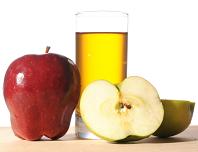 |
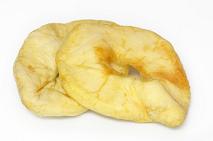 |
Reduce the Risk of Cancer: The flavonoid, quercetin, is found in apple skin along with other phytonutrients and phenols which are believed to inhibit cancer. During 2016, the University of Perugia conducted a study and found eating apples would reduce the likelihood of five specific cancers; stomach, breast, lung, oesophagus and colon.
Lower Asthma Risk: Apples also contain a flavonoid called phloridzin. This has been linked with healthy lungs and thereby lessening the occurrence of asthma attacks.
Promotes Healthy Digestion: Apples aid our digestion. They contain malic and tartaric acids and hinder food from fermenting in our stomachs. The skin of an apple contains insoluble fiber which literally pushes the food through our bodies. Note that if you do not eat the skin, the level of fiber almost halves.
Weight Loss: Apple skin can be quite chewy. It makes our brains think we’ve eaten more than we have and therefore aids weight loss as we will eat less.
To get the maximum benefits from apples choose – the most nutritious types of apples!
The Most Nutritious Types of Apples
Studies have shown that different apple varieties have different phenols and flavonoid compounds. There are more than 7,500 different varieties of apple. The Roman Beauty has a higher phenolic content compared to Idared Cortland and Golden Delicious. Among US varieties, Fuji apples and Red Delicious have high phenols and flavonoid content. These apple varieties also have higher antioxidant activity.
With the majority of apples, quercitin and fiber are contained in the apple skin. Unfortunately, the apple skin will likely contain chemical residue so ensure it’s fully washed. Since peeling the skin will result in the loss of the most nutritional part of the fruit, look out for organic apples. Apple juice is a poor substitute to fresh apples as it lacks fiber, and the nutritious benefits from the skin, however, it’s still a great thirst quencher.
In the table below we’ve compared apples with and without skin and apple juice so you can clearly understand the nutrients you will get.
Compare apple nutrition facts to the other fruits.
Raw Apple, Apple Juice, and Dried Apple Nutrition Facts
| Apple nutritional value per 100 g (3.5 oz) Scientific Name: Malus sylvestris |
|||||
|---|---|---|---|---|---|
| Proximates: | |||||
| Nutrient | Apples, raw, with skin | Apples, raw, without skin | Apple juice, canned or bottled, unsweetened, without added ascorbic acid | Apples, dehydrated (low moisture), sulfured, uncooked | Apples, dried, sulfured, uncooked |
| Water | 85.56 g | 86.67 g | 87.93 g | 3.00 g | 31.76 g |
| Energy | 218 kJ (52 kcal) | 200 kJ (48 kcal) | 197 kJ (47 kcal) | 1448 kJ (346 kcal) | 1017 kJ (243 kcal) |
| Protein | 0.26 g | 0.27 g | 0.06 g | 1.32 g | 0.93 g |
| Carbohydrates | 13.81 g | 12.76 g | 11.68 g | 93.53 g | 65.89 g |
| Total Fat: | 0.17 g | 0.13 g | 0.11 g | 0.58 g | 0.32 g |
| Fiber | 2.4 g | 1.3 g | 0.1 g | 12.4 g | 8.7 g |
| Cholesterol | 0 mg | 0 mg | 0 mg | 0 mg | 0 mg |
| Minerals: | |||||
| Calcium, Ca | 6 mg (0.6%) | 0.5 mg (0.5%) | 7 mg (0.7%) | 19 mg (2%) | 14 mg (1%) |
| Iron, Fe | 0.12 mg (0.6%) | 0.07 mg (0.4%) | 0.37 mg (2%) | 2 mg (11%) | 1.4 mg (8%) |
| Magnesium, Mg | 5 mg (1.3%) | 4 mg (1%) | 3 mg (0.8%) | 22 mg (6%) | 16 mg (4%) |
| Phosphorus, P | 11 mg (1%) | 11 mg (1%) | 7 mg (0.7%) | 55 mg (6%) | 38 mg (4%) |
| Potassium, K | 107 mg (2.2%) | 90 mg (2%) | 119 mg (2.5%) | 640 mg (18%) | 450 mg (13%) |
| Sodium, Na | 1 mg (0.04%) | 0 mg | 3 mg (0.1%) | 124 mg (5%) | 87 mg (4%) |
| Zinc, Zn | 0.04 mg (0.3%) | 0.05 mg (0.3%) | 0.03 mg (0.2%) | 0.29 mg (2%) | 0.20 mg (1%) |
| Copper, Cu | 0.027 mg (1.4%) | 0.031 mg (1.6%) | 0.022 mg (1.1%) | 0.271 mg (14%) | 0.191 mg (10%) |
| Manganese, Mn | 0.035 mg (1.8%) | 0.038 mg (1.9%) | 0.113 mg (6%) | 0.128 mg (6%) | 0.09 mg (5%) |
| Selenium, Se | 0 mcg | 0 mcg | 0.1 mcg (0.1%) | 1.8 mg (3%) | 1.3 mcg (2%) |
| Vitamins: | |||||
| Vitamin C | 4.6 mg (8%) | 4 mg (7%) | 0.9 mg (1.5%) | 2.2 mg (4%) | 3.9 mg (7%) |
| Thiamine (Vit. B1) | 0.017 mg (1.1%) | 0.019 mg (1.3%) | 0.021 mg (1.4%) | 0.046 mg (3%) | 0 |
| Riboflavin (Vit. B2) | 0.026 mg (1.5%) | 0.028 mg (1.6%) | 0.017 mg (1%) | 0.13 mg (8%) | 0.159 mg (9%) |
| Niacin (Vit. B3) | 0.091 mg (0.5 %) | 0.091 mg (0.5%) | 0.100 mg (0.5%) | 0.68 mg (3%) | 0.927 mg (5%) |
| Pantothenic acid (B5) | 0.061 mg (0.6%) | 0.071 mg (0.7%) | 0.063 mg (0.6%) | 0.432 mg (4%) | 0.245 mg (2%) |
| Vitamin B6 | 0.041 mg (2%) | 0.037 mg (2%) | 0.030 mg (1.5%) | 0.28 mg(14%) | 0.125 mg (6%) |
| Folate (Vit. B9) | 3 mcg (0.8 %) | 0 mcg | 0 mcg | 1 mcg (0%) | 0 |
| Vitamin A | 54 IU (1 %) | 38 IU (0.7%) | 1 IU (0.02%) | 81 IU (2%) | 0 |
| Vitamin E | 0.18 mg (1%) | 0.05 mg (0.3%) | 0.01 mg (0.05%) | 0.75 mg (5%) | 0.53 mg (3%) |
| Vitamin K | 2.2 mcg (3 %) | 0.6 mcg (0.8%) | 0 mcg | 4.3 mcg (5%) | 3 mcg (4%) |
| Percentages are relative to US Recommended Daily Intake (RDI) for adults. | |||||
Author: Lana Soko
Apple Recipes
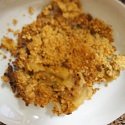
This Apple Crumble recipe is both simple to make and delicious. It's high in fiber, but also high in calories, so perfect for that occasional treat. A simple mix of apples, cinnamon, butter and flour. Just 15 minutes to prepare and 45 minutes to cook. Enjoy!
You Might Also Like:
Like This Page?
|
Share This Page:
|
